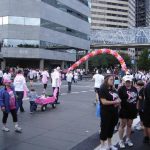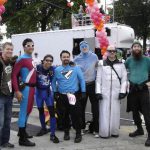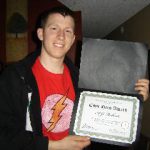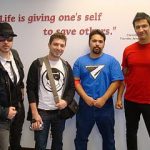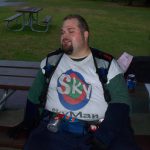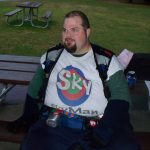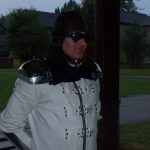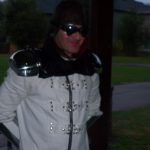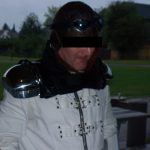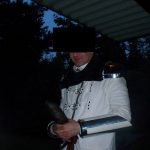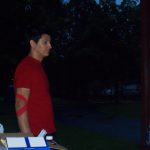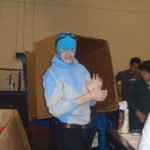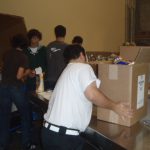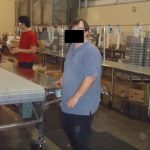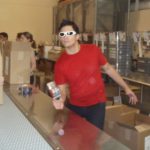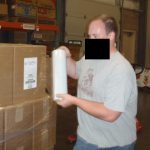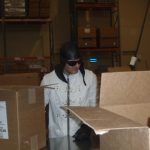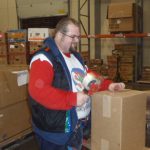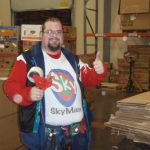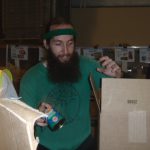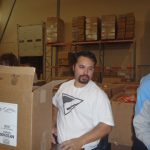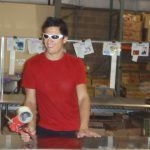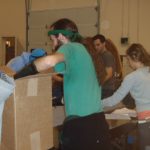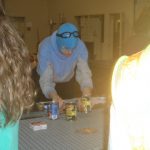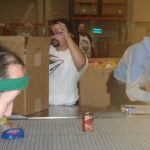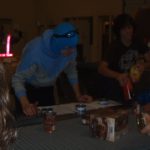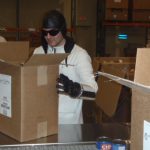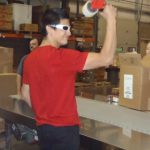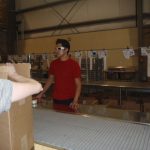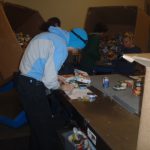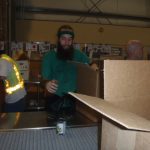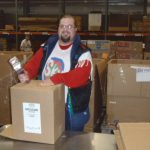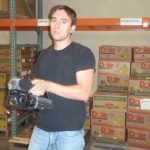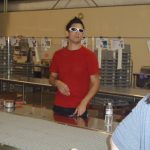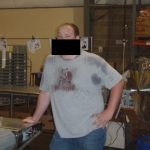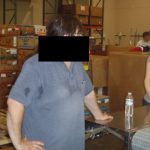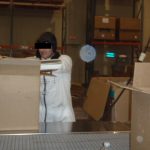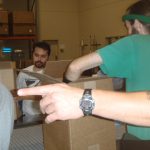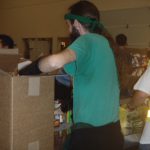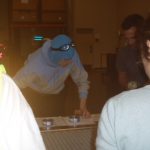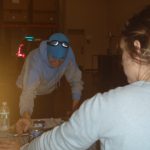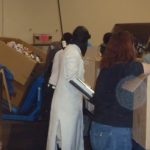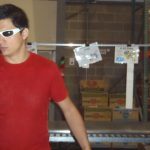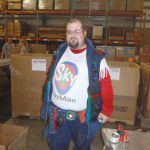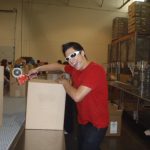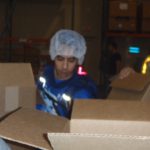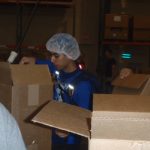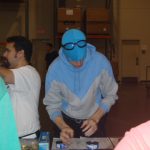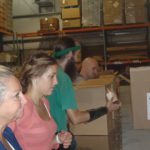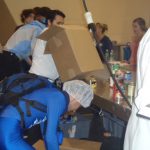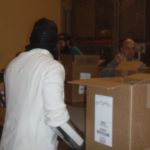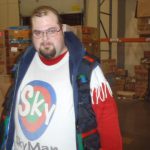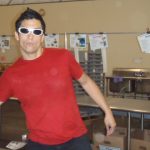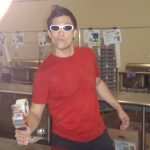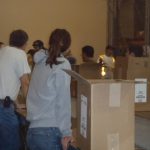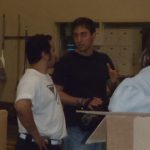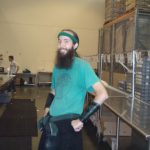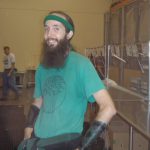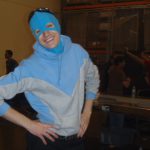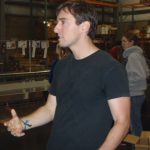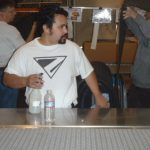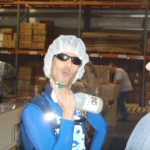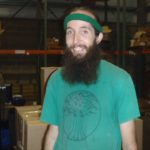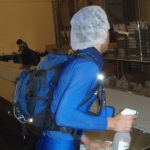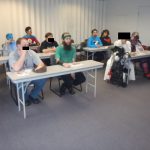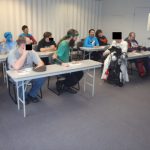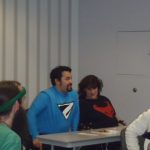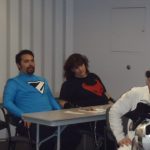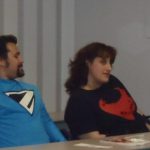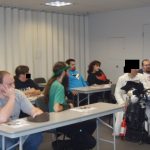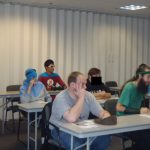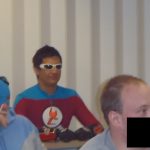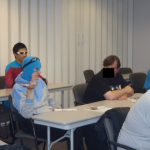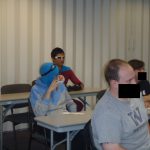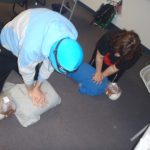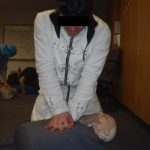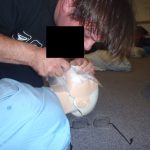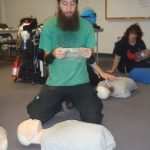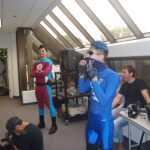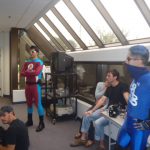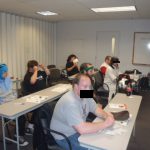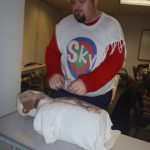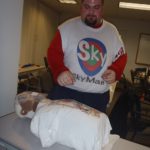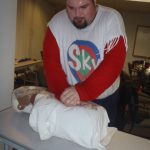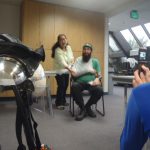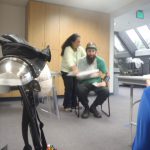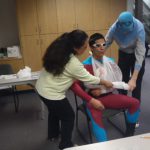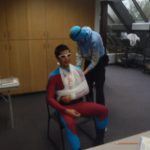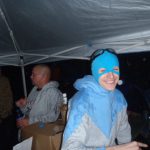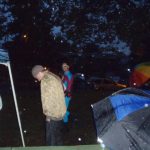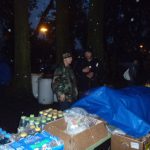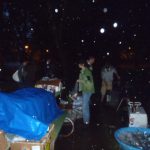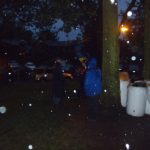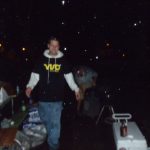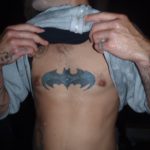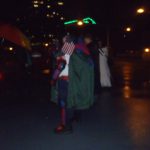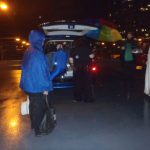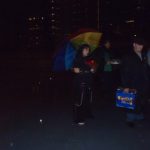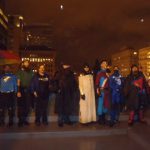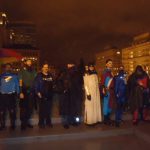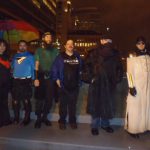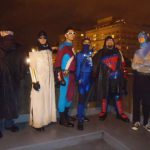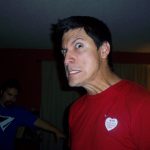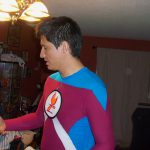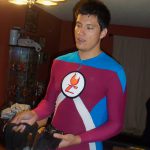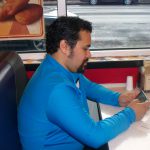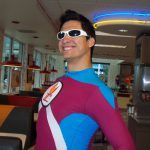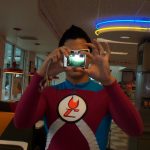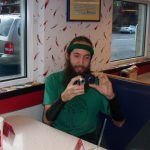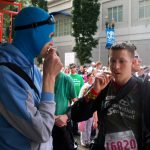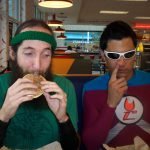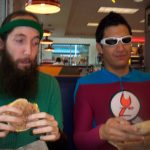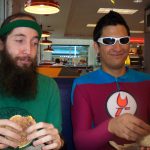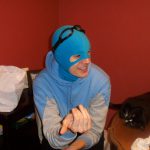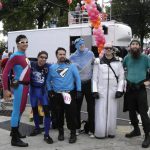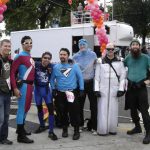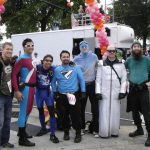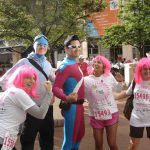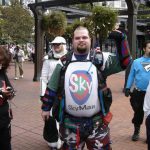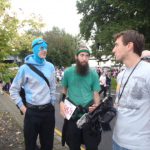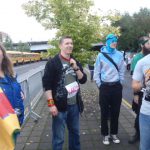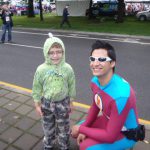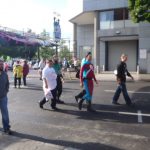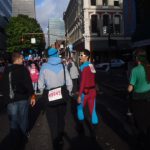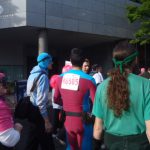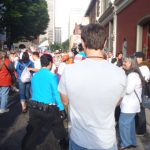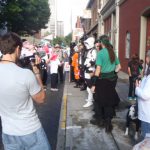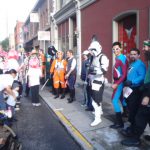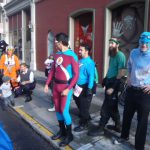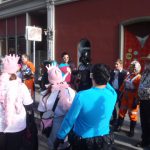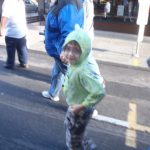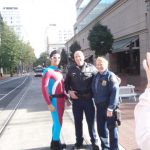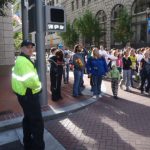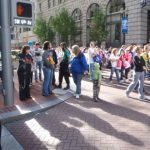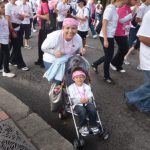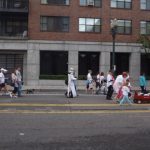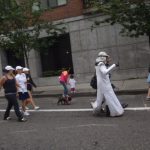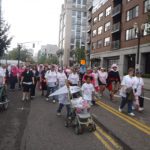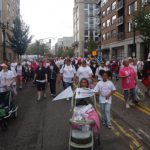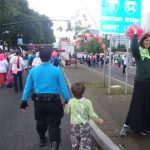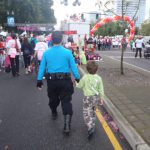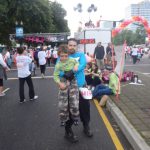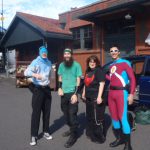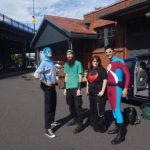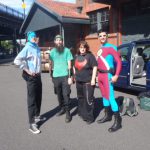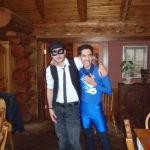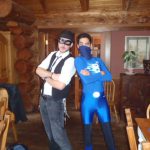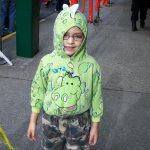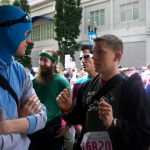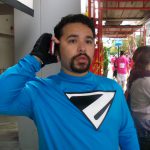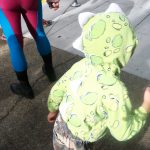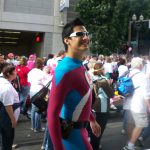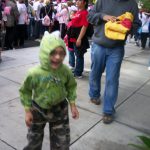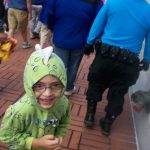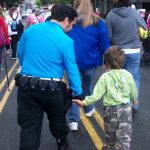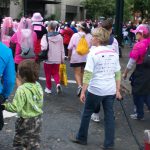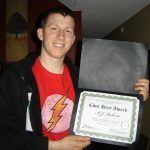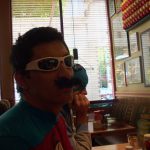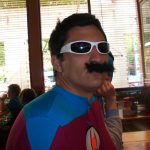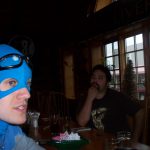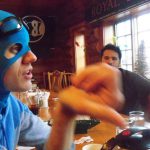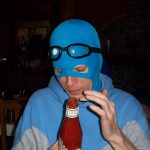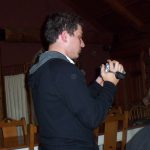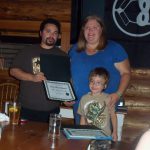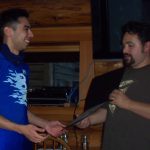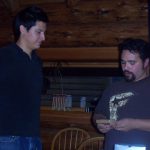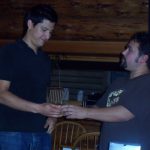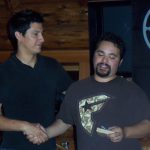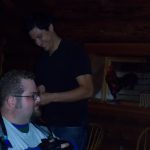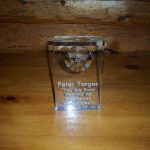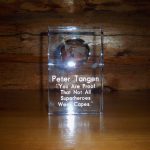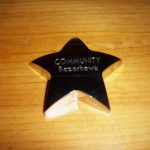Superheroes Anonymous
 Originally posted: http://www.sccougar.com/features/superheroes-anonymous-1.1595742
Originally posted: http://www.sccougar.com/features/superheroes-anonymous-1.1595742
How Costumed, Creative Altruism is Sweeping the Nation
Published: Monday, September 13, 2010
Updated: Monday, September 13, 2010 19:09
By Matthew Weitkamp
It’s late in New York City. Darkness has fallen and roaming the streets are the downtrodden and forgotten: Homeless men and women, starving and alone, cry out for hope. Their cries are being answered in the form of a masked man who stalks the streets with food and water, swooping in to help save these poor souls from a horrible fate. It’s late in New York City, and a superhero is saving the day.
A new wave of charity is sweeping across the landscape of our Nation. Costumed, creative altruism has set its roots. There is no ‘Justice League’ or ‘Avengers’ group, however. There is no centralized organization where the heroes meet to plan their war on crime. Across the country there are as many as 300 costumed heroes, all unconnected with one another. But individually they are still pushing past a skeptical society; one that is wary of their intentions.
New York is home to one such hero, “Life”, who walks the streets with determination to make the world better, and leave it better than how he found it. Born into a Hasidic Jewish family, Chaim (which is Hebrew for Life) took the teachings of his father, a Rabbi, to heart. When a person has something to give, regardless of how little, you must give to those who need it more than you.
“My family taught me that charity and helping other people isn’t optional. There are horrible, horrible injustices in the world and if you can do something, even a little, to make things better then you should.” Chaim has taken a piece of his Jewish faith, that charity is compulsory, and turned that into one of the code of ethics for Real Life Superheroes.
Life, a co-founding member of the Not-For-Profit organization, Superheroes Anonymous, is not the same kind of hero you’ll find in the pages of Batman or Spider-man. He doesn’t beat up thugs or commit vigilante justice. Instead, Life uses his time to help the homeless and inspire others through his actions. “I’m a realist. I’m a grounded person, as much as a man who wears a mask is a realist.”
Every night Life takes a backpack filled with necessity items with him out onto the streets. He gives bottled water, candy bars, tooth brushes, and a listening ear to all the homeless he meets. Everything Life gives he buys himself; a personal investment financially in his own desire to change the world. An expensive proposition, when you think about it. But for Life, that investment is worth it.
Life says he’s often asked why he wears a costume. Plenty of people can perform charity without dressing up or wearing a mask – so why does he? “Like a police officer, firemen […] even a business man: It’s a uniform … [you] feel like you stand for something. You wear the costume and you feel like a superhero”
“A costume draws attention to yourself,” explains Life, on why the costume is necessary, “and gets people to notice you.”
People can be inspired to do charity, Life says, when they see a mask or a cape. “You don’t have to be Batman and take down huge criminals or stop a war.” He says it’s all about what each of us can do, today, to make a difference.
“Start small, start realistically. What do you have the time and resources to do? … I get (emails for advice) all the time. They always have big goals. ‘I want to do this and that – I want to clean up my city of crime’. And I go ‘ok, but you don’t have the power to do that right now? What can you do, now, that’s small?’ You have to start small and be realistic.”
And how long will Life continue to be a Superhero? He admits that, while he won’t hang up his mask anytime soon, his role as a superhero might change over time. “I see Superheroes Anonymous becoming a Not-For-Profit organization that supports real life superheroes […] I won’t ever stop doing charity work. If it means being behind a desk instead of on the street, then charities will need that too.”
His outfit, like his attitude, shows just how adult Life is. Chaim doesn’t wear a cape or a cowl – he wears a tie and a Fedora. He’s a professional, working on the streets of New York City, presenting himself as a man who takes that one step further. Should Life ever need to take on a new role of heroism, like that of an executive for his organization, he feels all he would have to do is take the mask off. The rest of his outfit is professional.
The choice to become a superhero is not exclusive to Life in this country, but his is an example of creative altruism at its finest. Like-minded citizens all across the country are doing their part, too. Heroes like Citizen Prime, from Florida, who works to establish more homes for orphaned youths, stand as beacons for men and women looking to take on a new role in the protection of American’s from social injustice. These superheroes are real, walking the streets as an Iconic symbol for a better world. Life stresses that even though they might look odd or different, they’re a necessity.
“As long as you find people in need, you’ll have a need for superheroes.”
Modern day costume heroes fighting to make the world a better place
Originally posted: http://scotlandonsunday.scotsman.com/features/Feature-Modern-day-costume-heroes.6513746.jp
Published Date: 07 September 2010
 By KATY ROSS
By KATY ROSS
That’s what many 25-year-olds do when confronted with the monotony of the hamster wheel of life, when nothing matters but who you are going to the pub with at the weekend and whether you happen to get lucky. Instead, each night when he gets home from his job at an non-profit organisation in Brooklyn, he goes to his wardrobe and pulls on his superhero costume, then goes about the important business of saving the world, one step at a time.
He is not alone. Lazaros, or ‘Life’, to give him his superhero moniker, is one of a legion who make up the real-life superhero movement, a worldwide community of loosely affiliated individuals committed to a broadly defined ethos of making the world a better place.
These people may look as though they have jumped out of a comic book or Hollywood blockbuster, but they are all ordinary citizens who haven’t got a super power between them. What they share is an all too human ambition to help solve some of society’s most challenging problems by donning masks and costumes and venturing into their respective neighbourhoods to feed the hungry, comfort the sick and protect the innocent.
“We are just people who want to make a difference,” says Lazaros, who co-founded the New York-based website Superheroes Anonymous, to bring superhero groups together through outreach, education and creative community service. “We are not delusional – we know we’re humans with limited abilities. But inside every human is the capacity to do something kind, brave and strong for our fellow humans; some among us simply choose to do so in secret.”
But why the need for costumes? Would these good deeds not be equally welcomed if carried out in jeans and T-shirts? Working from the basic premise that the definition of a real-life superhero is someone who creates their unique persona to do good acts for others, Lazaros believes that “just because you are becoming something greater than yourself when you do these acts of good does not mean you have to be wearing a mask while doing them.
Nevertheless, the costumes do provide a universal symbol of good that people can recognise. When my father went out on the streets dressed as a Rabbi, people recognised him and trusted him. Dressing up in a superhero costume means something similar to me.”
The Real Life Superhero Project is photographer Peter Tangen’s attempt to document the work of the individuals who make up the movement. “They are some of the most amazing people I have ever met,” he says from his home in Los Angeles.
“As I researched the project I was struck by the irreverent and almost insulting tone of some of the reporting into these altruistic people who devote their time and effort into helping others. Their approach is very savvy though. In some ways they are marketing good deeds. They are drawing attention to personal power in an entirely unique way.”
Despite the hurdles the movement faces, its numbers are growing fast and are currently estimated to be in the region of 250 to 300 around the world. The work they do is varied; for example, The Cleanser will actively go out and clean the streets. Direction Man will go out and offer directions.
Other people have less specific personas and just aim to help. With great costumes, though, comes great responsibility, and while the superheroes are united in their aim to make the world a better place, their community has at times been divided on how that should be done.
Some members advocate a high-profile existence, helping the less fortunate through established non-profit organisations. Others want to fight the bad guys, vigilante-style, hiding in the shadows while supporting the work done by those in law enforcement.
Before moving to New Jersey to be with her boyfriend, 20-year-old Nyx, like Peter Parker in Spider-Man, prefered to keep her true identity secret. Living in Kansas, she would secretly take photographs of drug dens and send them to the authorities.
“It was dangerous work and I used to carry weapons. But I’m in New York now and things are different,” she says.
“We need to remain focused about our aims. I ask myself how I can be most productive. I want to help people feel safer and happier, but the best way I can do that is by volunteering. So now I work with my boyfriend at a homeless shelter. Everyone has it in them to make a difference, and I think this is the best way I can help.”
In Atlanta, Crimson Fist, a compact 5ft 6in, admits on his first night patrol it was the shock of seeing a man in a red and white cape and mask that scared off the two men he had confronted in an alley for attacking one another.
With a history of substance abuse, he says his superhero work is an attempt to make up for treating people poorly in the past.
“Generally when I go out on patrols I pack up a backpack with different supplies – in the summer I hand out bottled water, in the colder months, I give them clean shirts and socks and things like that.”
Citizen Prime, real name Jim, works for an unnamed financial institution by day and is one of the most respected members of the superhero community. Recently retired, he is consulted by many of the other super- heroes for advice. Prime distributed literature on drugs and crime and boasted a $4,000 custom-made outfit with breast armour.
On reflection, he likes to think his humour was his key weapon in diffusing awkward situations as he patrolled the streets of Arizona.
It would be easy to assume the actions of these members, and the many others committed to the movement, stem from a sense of disillusionment with society’s limitations, and that the new breed of superheroes are simply looking to find purpose in their lives. This isn’t always the case though.
Many of these people come from extremely successful backgrounds. Some are employed by non-profit organisations but others work on Wall Street or in politics.
As Peter Tangen puts it: “These people come from all walks of life. The organisation is very focused but it isn’t political. There are committed Democrats, Republicans, the whole spectrum of society is included. These are people with relationships, families, successful lives.
“They are not people who are lacking. They are people who are doing what they can to make a difference to the world they live in.”
For Lazaros, the motivation to get into the movement wasn’t through some sense of disillusionment, but more a desire to share his good fortune. Raised in the Jewish tradition of leaving the world a better place than the way he found it, he was imbued at an early age with strong values of charity, courtesy and kindness, modelled for him by his Hassidic parents, who always gave to others, even when it was hard to do so.
This moral code, underscored with a powerful sense of social justice, led him to his work with the homeless and disenfranchised.
Now minimally costumed in a mask, tie and jacket, he sets out every day with a backpack brimming with toothbrushes, lotions, soaps, even sweets, delivering the smaller necessities of life that fill in the gaps left by the NYC Department of Homeless Services.
The challenge, as Lazaros sees it, is to find people who are creative and altruistic and encourage them to express those charitable impulses in ways that may range from the subtle to the extreme. It is also what he sees as the ultimate mission of Superheroes Anonymous. “If I can inspire someone to do even the littlest of things to help others, and they in turn can do the same, think of how many thousands can be helped.”
www.reallifesuperheroes.com
This article was first published in Scotland On Sunday on Sunday, 5 September, 2010
Those Aren’t Luchadores: Real-Life Superheroes
 Originally posted: http://nerdbastards.com/2010/08/13/those-arent-luchadores-real-life-superheroes/
Originally posted: http://nerdbastards.com/2010/08/13/those-arent-luchadores-real-life-superheroes/
by Jeff Sparkman
Lots of nerds have dreamed of being a superhero, myself included. Alas, I didn’t have the fortune to have been sent to Earth from a doomed planet as an infant, and I have yet to be offered a position as an intergalactic cop. Plus, with me being colorblind, that could cause some confusion between the Green Lanterns and Red Lanterns.
That pretty much leaves the option of being a DIY superhero. And this is the point at which the average enthusiast says, “Aw, screw it.” Seriously: if you have a hard time even making it to the free pilates classes at work even though it’s in the conference room just down the hall, how are you going to make time to train and become a paragon of strength and athleticism?
Batman had the advantage of having money out the ass, so he could afford to go train with the finest in the world. Us? Community college, the YMCA, or private lessons with Sensai Wynoski.
Also–and not to pick on Batman, but he’s the perfect example of a nonpowered hero–Batman could afford a high-tech outfit to wear while fighting crime.

You know how much of a bitch it is to sew a Spandex costume? That shit stretches even if you just look at it, so when you’re cutting it, the pieces can end up distorted. Plus, you need a surger to get seams that will stretch with the Spandex. Sure, you can half-ass it with a zigzag stitch on a regular sewing machine, but you take some risks.
The last thing you want is to drop down from a fire escape to intimidate a mugger and have your pants rip when you land and your junk pops out. That’s not the image you want to give.
Or maybe it is; I’m not here to judge.
Fucking perverts.
Anyhow, it is equally heartwarming and disturbing that there are people trying to live the superhero dream in real life. If you go to the World Superhero Registry (suck on that, Civil War), you can see dozens of our protectors of humanity.
And no, it’s not a total sausage fest, either; there are superheroines, too. The thing you probably never thought about before is abundantly clear when you look at the list of heroes: the comic publishers have taken most of the good names. Not to diss the real-life guardians of justice, mind you. They’re doing the best they can with what’s left over.
So really, even before they hit the streets to fight crime, they’ve got the odds against them.
1) No powers
2) Superhero costumes don’t transfer well into real life
3) People think you are a few fries short of a Happy Meal
4) You are stuck with a name like Dildor the Penetrator
5) Okay, that’s actually not that bad of a name, but you know what I mean.
6) I already have dibs on using Sparkman as a hero name, so don’t even try it.
There’s video about the real-life heroes:
httpv://www.youtube.com/watch?v=Z7pB2gLZtlY
I think it’s pretty awesome that these superheroes are helping out in their communities, like assisting the homeless and stuff, but if you want to be an effective superhero, I would steer clear of local news broadcasts, because you know they’re always going to stick you in the same slot they reserve for the guys dressed as Klingons at Star Trek conventions or old men with soda can collections. It reduces your street cred. For crap sakes, don’t give your real name!
This is just me, but can you heroes switch from having MySpace pages? That just looks bad.
But sincerely, keep up the good work. People may talk shit, but at least you’re doing something to try to help. Stay safe.
(via Kotaku)
Real Life Superheroes…with Capes
Originally posted: http://modestneeds.typepad.com/modestneeds/2010/08/real-life-superheroeswith-capes.html

In North America exists a team of superheroes. They don’t have their own comic book or 3D movie or long running TV series, but what they do have is the drive help those around them. They are on a mission of “activism and altruism.” In crazy costumes.
They are the The Real Life Superheroes, and they roam the streets of New York bestowing good deeds on those who need them.
There is Nyx, who focuses her efforts on aiding the homeless in New Jersey.
There is The Crimson Fist who tends to addicts in Atlanta.
And there is Life, my personal favorite, who hands out essential toiletries like toothbrushes to those on the streets of Manhattan. He is also the co-founder of Real Life Superheroes.
Here’s a short clip with Life, who explains why he does what he does. Mask and all:
httpv://www.youtube.com/watch?v=9LLlY8UYiyU
This is such a fantastic idea, and one that could very easily be a project for children. Who better to participate in such a project than kids who are already way into superheroes, but also the perfect age to establish a lifelong trend of philanthropy. Your little caped crusaders could volunteer to walk dogs at the local shelter. Your daughter could register to run a fundraiser-for-charity 5K and run it in a mask and cape. The possibilities are innumerable, and what a fun way to instill a charitable mindest in a child.
Who knows, maybe for Halloween your second grader will want to be Connie the Canned Food Collecting Crusader.
LITTLE REMINDER: Modest Needs is in 4th place in the Pepsi Refresh Project, and your daily vote will be the only way we can move up and secure $250K for the unemployed Gulf oil spill victims. A click and you’re out. Thanks so much for your time and support!
The Real Life Super Hero Project
Originally posted: http://www.comicbookresources.com/?page=article&id=27754

By Shaun Manning, Staff Writer
With heroic names like Life, KnightVigil, the Crimson Fist and Thanatos, the subjects of photographer Peter Tangen’s latest project might sound like new and exciting additions to the Justice League, or members of a new superteam spinning out of the Avengers. In fact, these and other heroes are members of a community that patrol the streets of New York City, Atlanta and Vancouver to give aid to the homeless, mentor at-risk youth and perform other charitable deeds – in real life. “The Real Life Superhero Project” is a collection of portraits, videos and movie-style posters created by Tangen and a team of volunteers, designed to celebrate the men and women who, for several distinct reasons and to many different effects, put on a costume in an effort to improve lives in their communities.
Tangen is a Los Angeles-based photographer whose primary business is shooting promotional materials including movie posters for films and television shows with the iconic posters of “Spider-Man” and “Batman Begins” among his works. The artist, who discovered the real-life superhero culture on the internet as he was looking for a project to undertake independently, told CBR that the culture has existed perhaps for decades but is experiencing a reemergence now. Most of the heroes do not know each other personally, but there is an active online community.
“Because I’ve done so much work within the genre of superhero movies, the idea that these people exist really appealed to me,” Tangen said. “I began to do a lot of research and discovered there’s quite a large community of people who are referred to by the media as ‘real-life superheroes.’ I decided I wanted to do a photographic essay on them.

“I went to Vancouver to do a photo shoot for a client, and I reached out to a man up there who goes by the name Thanatos,” Tangen continued. “At the time, he was a 61-year-old man in Vancouver and his short story is that he was going out at three o’clock in the morning in civilian clothes, just giving food and supplies to people who were living on the streets and not getting into the shelter system. He felt, after doing it for three years, that he wasn’t being especially effective. The people he was helping wouldn’t recognize him from previous visits and he wasn’t really creating any sense of awareness of his efforts.” Awareness, Tangen explained, was not for Thanatos’s benefit but to create a sense of continuity, to give the idea that a certain person cares rather than simply being one of a succession of anonymous, one-time givers who might never think of the beneficiary again.
“He wanted to take it a step further. The local police department had indicated to him that the only thing that people on the streets of Vancouver have to look forward to is death. So he decided to take on the identity of Thanatos, which in mythology is the god of death,” Tangen said. “What he’s discovered since deciding to do this a year and a half or so ago, maybe two years now, is that the people he helps remember him. I’ve been on the streets with him at three o’clock in the morning, doing a homeless outreach, and I’ve seen people that have never met him before and I’ve seen people he’s helped for quite some time. There is a different reaction because of the appearance than you would have if he were in civilian clothes.
“He’s effectively marketing good deeds. For people who are living on the streets, who have no real community besides those on the streets with them, he creates in them a sense of belonging, that there’s someone looking out for them, which is impossible to do in civilian clothes because you’re not easy to remember,” the photographer continued. “So the work he does up there is really quite extraordinary and he does it all self-funded. And he gives people his business card when he meets them – which is, you know, a business card for Thanatos and on the back of it, it says ‘Friend.’ I’ve learned that what he’s trying to do is just make a difference in the world in a small way, but the effect he has is that can identify with them in a way that is much more impactful for someone on the streets that he may be helping. Because there’s one person helping them on a regular basis, instead of the anonymity of passing strangers, what he’s done is remembered.”
Thanatos was the first to be photographed, and his stature within the real-life superhero community made him an effective advocate for Tangen’s project, which the photographer hopes will be a departure from the way the community is normally presented in the media. “In my research, I learned that stories about these people are being treated in three ways by the media: the first and most common reaction the media has is to exploit them or mock them or do a light-hearted puff piece that isn’t in any way serving them,” Tangen told CBR. “Second to that, and less common, is an investigative journalism approach, just looking at what these people are and what they do. It’s a little bit more intellectual, but it is still without opinion: this is what they do, you make up your mind whether they’re crazy or not. It also doesn’t really react to the effects that they have on the world around them.
“On rare occasions, people in the media have discovered this culture of people and understood that in fact the stories they tell and what they stand for can actually be very inspirational. Because, in effect what they stand for is the idea that one person can make a difference. And I can tell you countless stories of how that’s actually the case,” Tangen continued. “I decided that I wanted to tell a story that was inspirational. Once you get past the idea of their costumes and you actually see what they’re doing, you realize that have actual real power that we all share. So I began to assemble my little plan with a group of collaborators. A couple weeks after I photographed Thanatos, we had 19 people from all over the country come into LA for a one-day photo shoot. It was quite an extraordinary event.”
Tangen noted that the day of the photo shoot was a significant even within the community itself, as it was the first time many of the heroes had met each other. “These people who came from across the land had the opportunity to meet people they’d been in communication with for several years but had never actually met. They had the chance to get together and talk about what they do.”
About thirty volunteers from the photography and film industries, using donated equipment and services, came together to work on the photo shoot. “Everybody that was there, was there because they had heard about these people and were inspired by the story. The impression people had at the end of the day was that it had been an amazing event,” Tangen said. “People said they felt they were literally better people for having been there and experiencing that event. If we had been hired to do what we did that day, not including the cost of actually flying people in, the photo shoot itself would have cost easily $100,000 to execute, but we did it for next to nothing because of the volunteer basis of everybody that was there.”
Tangen said the posters were designed to show the heroes “not how they see themselves, but how the people they help see them,” and were created in the style of movie teaser or character posters to portray a series of individual stories. “Generally speaking, it’s a rule of thumb that a really good movie poster tells a story. It may not be the story of the movie from start to finish, but it tells a story enough that it piques the interest of the viewer and tells enough about what the movie is that they understand what they’re going to go see,” Tangen explained. “The content of the movie poster is typically three different elements: one is the visuals, whether photographic or illustrative or a combination of those things. Another is the copy that might be tied to the poster. And then the third is just the title of the movie. Each of those elements should add to the overall narrative of what the poster is. So if you have a Tom Cruise movie about a secret agent and it takes place during wartime, you don’t want to tell all of that in a line of copy. You want to have the visuals and the title of the movie add up to that information.”
Taking the example of the “Life” poster, the first to appear on his Real Life Super Hero Project website, Tangen walked through the thought process. “Since he’s so much in the street, he rarely goes anywhere without granola bars or something that would enable him to help someone who’s helpless or needy, we decided that we would have him reaching into a group of people that could use his help. It’s a very visual tool to get that message across. And because he’s so much in the streets of New York City, we chose a New York City location for the background image. Since he was raised a Hasidic Jew, we decided we were going to use the Hebrew text for the word ‘chai,’ which is translated into ‘life,’ for what would be in other posters the title of the movie. Then for the copy line, we further express the idea that, where people make an effort to help others, there’s a further opportunity for those who are being helped to have hope,” Tangen said. “Those elements together talk about him, where he is, what he stands for and the optimism that he inspires in people that he serves.”
In addition to the movie-style posters, Tangen and his crew created a series of other photographic pieces. “We did a couple of group shots that are very definitely an homage to Alex Ross; straight up, out of the box, we’re not ripping him off – we’re honoring him. The other thing done is [we created] a series of portraits, which you can see a few of on the website,” he said. “As much as the posters are meant to show them as they are seen by the people they help, the collection of portraits was shot very much in the same style, with the intention of having the viewer look past the mask, perhaps identify with the real human being behind the outfit and and hopefully discover themselves the relatability of that person as a regular person and find in themselves a hero they may have not known existed.”
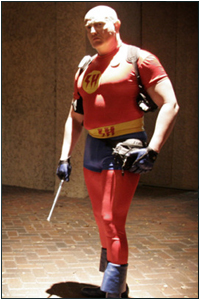
NYC RLSH Patrol
NYC Patrol 07/31/2010 – by Dark Guardian

Met up with Thre3, Life, Blindside, Tothian, Shade, Smaratin and Cameraman. We met at Washington Square Park. Good Morning Japan came out for part of the patrol. They were very friendly and I am looking forward to seeing the finished news piece which will be released exclusively on www.RealLifeSuperheroes.org .

We patrolled around the park veering through the side streets. Drug dealing in Washington Square Park has been tamed down. If there is dealing goign on it is a very small amount of people and there seems to be no hard drugs. We worked our way up to Union Square Park. We helped a lot of people on the way. Life and Cameraman brought a great deal of supplies to give out. We handed out food, water, socks, shirts, tooth brushes, vitamins, razors, and more neccesities. We stopped and talk to different people as we patrolled the streets telling them about what we do. A couple people were interested in possibly doing it themselves. Nothing too exciting happened just an average patrol. Made sure some guy on heroine was doing ok on the streets. Stopping some guy from climbing over a park fence. We found a lot of homeless people staying in Union Square Park. We wound up running out of supplies. Now we know where a lot of the homeless are staying so we can go back and give aid to them. Tothian and Samaritan did a bike patrol after the group split up.
Bleeding Cool RLSH In Pictures
Original content – http://www.bleedingcool.com/2010/08/01/the-real-superheroes-in-pictures/?utm_source=feedburner&utm_medium=feed&utm_campaign=Feed:+BleedingCool+(Bleeding+Cool+Comic+News+&+Rumors)&utm_content=Google+International
The Real Superheroes In Pictures
Submitted by Rich Johnston on August 1, 2010 – 6:29 am
Bleeding Cool has run a number of articles on real so-called superheroes, people who dress up in costume and perform anti-crime patrols and responses in their local neighbourhood.
But we never thought to make them look as much as comic book superheroes as possible.
Real Life Superheroes is an online project to do just that. And the results are nothing short of spectacular.
And here are a few videos talking to these ladies and gentlemen who take cosplaying to a whole new level.
Decouvrez les vrais super-heros
Originally posted – http://www.fantasy.fr/articles/view/14021/decouvrez-les-vrais-super-heros
Découvrez les vrais super-héros
The Real Life Super Hero Project met des coups de projecteur sur les super-héros du quotidien.
Par Emmanuel Beiramar
28 juillet 2010 | Mis à jour 28 juillet 2010
Les super-héros se classent en plusieurs catégories :
Il y a les super-héros mutants comme Wolverine ou Magneto.
Il y a les super-héros extraterrestres ou venant d’autres dimensions comme Superman ou Thor.
Il y a les super-héros nés d’un accident comme Spider-Man ou Hulk.
Il y a les super-héros sans pouvoirs comme Batman, Iron Man, la plupart des Watchmen ou les héros de Kick-Ass.
Et il y a les super-héros du quotidien. Ceux qui existent vraiment et qui tentent d’aider leur prochain. Ils sont costumés, « Anonyme et désintéressés», nous explique le site de The Real Life Superhero Project. « ils choisissent tous les jours, de faire une différence dans le monde qui les entoure. Qu’il s’agisse de nourrir les affamés, réconforter les malades, ou nettoyer leur quartier, ils sauvent de vraies vies, de façon très concrète. Ce ne sont pas “des excentriques en costumes », comme on pourrait le croire au premier coup d’œil. Ils sont, tout simplement, une réponse radicale à un problème … radical. »
Le photographe Peter Tangen, dont on peut voir le travail sur des affiches de Batman Begins ou Spider-Man, a décidé de s’intéresser à ce mouvement particulier. Il a contacté 20n de ces super-héros du quotidien pour les prendre en photos, dans leur costume.
Conçu à la base comme une exposition, The Real Life Superhero Project a pris de l’ampleur et attire de plus en plus de personnes, qu’il s’agisse d’artistes, de musiciens, de sportifs ou même d’hommes politiques. Le projet leur donne envie de devenir plus actifs, plus impliqués, plus engagés, et peut-être, un peu plus « super » dans leur vie de tous les jours.
Pour plus d’informations, rendez-vous sur le site officiel de The Real Life Superhero Project.
Translation to English
Discover the real heroes
he Real Life Super Hero Project puts the spotlight on the heroes of everyday life.
by Emmanuel Beiramar
The superheroes fall into several categories:
There are superhero mutants like Wolverine or Magneto.
There are superheroes or aliens from other dimensions like Superman or Thor.
There are heroes born of an accident such as Spider-Man or Hulk.
There are superheroes without powers like Batman, Iron Man, most of the heroes of Watchmen or Kick-Ass.
And there are the heroes of everyday life. Those that do exist and trying to help others. They are dressed, “Anonymous and disinterested,” explains the website of The Real Life Superhero Project . “They choose every day to make a difference in the world around them. Whether feeding the hungry, comforting the sick, or clean their neighborhood, they save real lives, in very concrete ways. These are not “eccentric costumes,” as it may seem at first glance. They are simply a radical response to a problem … radical. ”
Photographer Peter Tangen, which can be seen working on posters of Batman Begins or Spider-Man, has decided to focus on this particular movement. He contacted 20n of these super-heroes of everyday life and take pictures in their costumes.
Designed from the ground like an exhibition, The Real Life Superhero Project has grown and attracted more and more people, whether artists, musicians, sportsmen and even politicians. The project makes them want to become more active, more involved, committed, and perhaps a little more “super” in their everyday life.
For more information, visit the official website of The Real Life Superhero Project .
Brooklyn’s Own Superheroes
Originally Posted: http://www.nypress.com/article-21418-brooklyns-own-superheroes.html
A fantastic foursome of Real Life Superheroes tackles crime fighting on borough at a time
By Tea Krulos
 Z bounces from foot to foot, ducking and weaving, and then works the bag: Left-Left! Right! Left! Right-Right! Left! Right! He keeps swinging while some heavy tracks from Penthouse (aka 50 Tons of black Terror) blast in the background. His fists connect with the punching bag so hard that it leaves gouges in his knuckles that he later bandages.
Z bounces from foot to foot, ducking and weaving, and then works the bag: Left-Left! Right! Left! Right-Right! Left! Right! He keeps swinging while some heavy tracks from Penthouse (aka 50 Tons of black Terror) blast in the background. His fists connect with the punching bag so hard that it leaves gouges in his knuckles that he later bandages.
The twentysomething is known only by that single letter, and is a member of a team of crime fighters known as The new York Initiative, a small group of brooklynbased vigilantes who spend their spare time fighting crime.
The new York Initiative is a splinter group from a worldwide movement of people calling themselves Real Life Superheroes (RLSHs), who adopt costumed personas of their own invention and take a number of approaches to the concept. It may seem like mere role-playing or a cheap copy of the popular The Watchmen comic and recent movie, but this growing cohort take their responsibility to do good seriously.
Some conduct charity fundraisers or visit children’s hospitals. others do civic duties like picking up litter or handing out food, water and supplies to the homeless. many do “safety patrols,” much like a concerned citizens’ walking group might. A few of the superheroes, like the NYI, actively fight crime. This anonymous, leaderless Justice League has been estimated to be anywhere from 100 to 400 members strong in cities from coast to coast, as well as around the world. They convene online in chatrooms and message boards or form groups on Facebook.
Unlike many other RLSHs who dedicate a small area for their alter ego—a spare room, basement, the trunk of their car or a sock drawer—the NYI have devoted their entire apartment to the lifestyle. A lot of the “crime fighting gear” is illegal in new York, so it remains unused, stored in the apartment. Z flaunts the collapsible batons, stun knuckles (that make a loud zapping sound), throwing knives and spiky hand guards that look like something Genghis Khan would brawl in.
He also hands me weapons out of an umbrella stand of pain: a couple of giant ax handles bound with duct tape, a metal pipe and an ordinary walking cane, which he wields as a fighting stick. Another rack holds more practical items such as protective arm gauntlets, gloves, flashlights, walkie-talkies and binoculars. I notice a decorative battle-ax and a pair of katanas. A workbench and shelves hold a mess of tools, building materials and armor.
The group’s “gadgeteer”—he calls himself Victim—shipped a box from his home in seattle with a sampling of different panels of polycarbonate squares, hoping to test the durability against a variety of weapons. Z shows a panel with a few minor dents in it; the polycarbonate has withstood a variety of knives and blunt instruments.
Then there’s Lucy, a kitten they found on the street that they nursed back to health. she’s purring and rubbing up against body armor. A strange juxtaposition of cute and cruel.
Near the workbench, a dry erase board lists some nYI goals for the next year. A mirror on the wall has a piece of paper stuck to it with a quote: “What can be broken, must be broken.”
Z shares his Brooklyn apartment with Tsaf and Zimmer, two other self-proclaimed superheroes. (since they are trying to maintain their anonymity, they asked that their exact location not be disclosed.)
 Tsaf (pronounced saph) is the team’s only active female member. she is small but toned and emits a Zen-like calm. While Z punches, she meditates in her room.
Tsaf (pronounced saph) is the team’s only active female member. she is small but toned and emits a Zen-like calm. While Z punches, she meditates in her room.
Zimmer, 22, has no secret identity or code name and since he already has a snazzy surname, he uses it. He first learned about RLSHs when he was a teenager in Texas. He later started patrolling at 18 in Austin. He moved to new York and has graduated from an EMT certification course and serves as the “field medic” for the team.
Zimmer gathers gear and adjusts the straps on his “Northstar non-lethal backpack,” a powerful but compact LED light, clasped to the chest with backpack straps. The light is blinding and can be used to daze attackers. When he demonstrates it outside, the spotlight hits the night sky like a bat signal searching the tops of buildings. The power source is a row of batteries in the bottom of the small backpack, wired to the light. His backpack also holds a first-aid kit, cPr mask and handcuffs in case of a citizen’s arrest.
The only person missing is Lucid. The fourth NYI member, Lucid isn’t available for the night’s patrol because he’s working his job as bouncer at a Williamsburg bar.
After a couple more rounds with the punching bag, Z sits down and begins strapping on his full body armor, a homemade medley of leather, pads and stainless steel bits and pieces, which he describes as a “poor man’s Iron Man suit.” The suit includes boots, leg, knee and ankle pads. A pair of arm bracers he made out of leather and steel are attached to his arms with truck ties and work as both defense and offense. To complete the look, he wears a black Predator-type mask sure to creep out anyone who sees it on the street. He then puts on his “butcher mail,” a stab-proof apron of metal scales over a lightweight bulletproof vest, which he then covers with a sleeveless, brownleather zip-up.
As Z buckles and snaps his gear into place, he begins to describe what it feels like to don his costume. “It depends who is around,” Z says as he pulls the straps on the arm bracers. “But I’d say it’s almost like a holy, sacred feeling for me.”
——————————————————————————–
REG BY DAY, SUPERHERO BY NIGHT
Z and Zimmer say they have similar goals, but they often have different ideas on the proper approach. Zimmer compares himself and his philosophies to the movie The Matrix and Z relates his persona to Fight Club. It’s a pretty accurate description of their personalities: Zimmer as the cyber rebel and Z as an enigmatic underground street fighter.
Zimmer has strong connections with the RLSH movement and is an administrator for the Heroes Network, one of the two major online forums for RLSH. His gear includes jeans with built-in kneepads and calf-high canvas shoes, along with his signature T-shirt printed with the binary code for the letter “Z” (01011010) in white numbers down the side. He also works as a freelance writer, churning out articles about science and technology, and his room is overflowing with piles of books on computer programming.
Z has chosen the last letter of the alphabet for other, mysterious reasons. He also explains that he’s had issues with the RLSH movement, including a couple of RLSH who claim they have “metaphysical powers.” He feels some RLSHs have inflated egos or are simply bloviating. And then there are the spandex outfits: Don’t even get him started.
“Everything I wear is either protective gear or to blend in during plainclothes patrols, with gear underneath. No spandex. Ever,” Z explains. “If I ever wear spandex, I deserve to get shot down in the street like the dumbass that I am.”
Z moved from Detroit to Philly and finally to New York, and his room is spare: the punching bag, some weights, a mattress.
Z and Zimmer say their goal in moving to the city was to assemble the NYI. Several others had planned to make the pilgrimage to New York as well, including Death’s Head Moth from Virginia and Lionheart from London. For a variety of reasons, it didn’t work out. The NYI remains a gang of four.
——————————————————————————–
SHOW AND TELL
On its website, the NYC Resistor describes itself as “[a] hacker collective with a shared space located in Downtown Brooklyn. We meet regularly to share knowledge, hack on projects together and build community.”
Zimmer claims to have a lot of involvement with hackers, and has spoken about RLSHs at two different hacker conventions, including one in Austria. “I think hackers and Real Life Superheroes have a lot in common in what they do, but a lot of people in this community probably don’t see that,” he says.
The three of us walk to the collective’s warehouse near the Fulton Mall for its first “Show and Tell” night, an open invitation to share any useful gadget. Inside, 15 or so people show off things: a portable UV light and a self-balancing unicycle. Zimmer takes the stage and demonstrates his Northstar and explains the premise of the NYI, and then calls Z up, who shows off his stainless steel arm bracers, clanking them together loudly. When he dons his new mask and turns on an LED light attached to its side, some in the audience gasp. Because the mask resembles the Predator alien, someone asks if he also has a missile launcher built into the shoulder. Afterward, one young man in his twenties approaches the duo, saying he’d like to be involved with tech support for the NYI.
As we head back to the NYI headquarters, we’re stopped half a block from the subway platform by the police. They ask to see what is in the metal suitcase we’re carrying and find Z’s arm bracers. “Skateboard pads,” Z explains. They seem to accept his explanation but decide to pat us down anyway. The cops tell us they stopped us because we’re white and therefore, the only reason for us to be in the neighborhood would be to buy drugs.
When Z and Zimmer say that they live a block away, the cops are surprised. “In fact, we’re trying to do something kind of like a community block watch or safety patrol,” Zimmer explains.
“Block watch?” one officer snorts. “Naw, fuhgetabout that. You’ll get shot. The guys in this neighborhood, they’ll shoot you and no one will tell us who did it. There’s a strong ‘no snitching’ rule out here.”
——————————————————————————–
SKATE-AND-BAIT PATROL
Warnings from police and others don’t deter the NYI, and shortly after encountering the cops that night, the trio of superheroes begin their pre-patrol rituals. They plan to stage a “bait patrol.”
The strategy is that Z will skate ahead on a longboard, a sturdy, fast skateboard made for cruising. The longboard is also a good excuse to be wearing a lot of protective gear. Next in the lineup is the bait (described as the “nucleus” of the patrol)—usually TSAF or Zimmer. In tonight’s case, TSAF wears a white dress, purple eye makeup and is carrying a bulky purse. She tries to lure predators looking for someone vulnerable. Zimmer follows on foot about a block behind her.
Lucid, if he were here, would act as a runner, skating back and forth on his longboard between the group members as they move forward. TSAF watches for Z; Zimmer watches for TSAF; and Lucid would be watching everyone. Communication is vital: All parties are connected by cell phone, ready to leap into action if anything happens.
——————————————————————————–
“I don’t see this movement fading away, superheroes are real now and there is no turning back.”
——————————————————————————–
It looks good on paper, but we encounter some problems. First, I am trying to keep up with Z, but my board is having some technical issues. We backtrack for a pair of pliers to fix the skateboard. Back on the street, we make it just a few blocks before determining that there are tech problems with the phones. The NYI can’t hear each other. There is much frustration all around, and Z decides to call off the patrol.
The next day, I skate around Brooklyn with Z, running errands. Z and the NYI are more or less everyday New Yorkers, trying to live their lives with normal friends and day jobs. Their secret night patrols are the only thing that makes them feel different. We end the day at a Williamsburg bar, where Lucid works security and the NYI spend spare time hanging out.
After a few games of pool, Z and I decide to skate around for a bit. That’s when we spot an intoxicated young woman stumbling along and tripping over her high heels down the empty street. “Let’s do an impromptu bait patrol,” Z says. “You fall behind, and I’ll skate ahead.” So we follow the woman for several blocks, trying to remain inconspicuous. I hang way back and gave Z a “thumbs up” sign periodically. The woman stumbles to a bus and boards. All clear.
——————————————————————————–
BATTLES IN WASHINGTON SQUARE PARK
Dark Guardian organized the meet-up under the Washington Square Park arch, while a horde of people enjoyed a science fair on a sunny day. Dark Guardian is from Staten Island and says he’s had several nighttime confrontations in the park. His goal is to try to kick drug dealers out of the park by himself or with other small groups of RLSH.
Armed with a crew of cameramen and a bullhorn, Dark Guardian has walked up to drug dealers in the dark corners of the park dressed in black motocross gear, telling them to leave.
Some left and some didn’t. He was often outsized and outnumbered, and he says one alleged dealer flashed a gun tucked into his waistband. Dark Guardian didn’t let it deter him. He returned to the park several times, relying on the confidence he’s acquired as a martial arts instructor.
Today’s meeting is meant to assemble other like-minded individuals. A few showed up: The Conundrum (New Jersey); Hunter and Blue, a dynamic duo from Manhattan; and Mike, who hasn’t picked a persona yet but is interested in the idea. Dark Guardian has been leading an effort to unite RLSHs of New York—including Nyx and Phantom Zero, Life, Champion, Thre3, Blindside and Samaritan—to work together.
Zimmer also decides to attend, a significant step in Dark Guardian’s quest to unite a larger group of people in New York. Zimmer and Z have had disputes with Dark Guardian, who administrates The Real Superheroes Forum (therlsh.net), which is similar to Zimmer’s Heroes Network. It turns out in real life, superheroes are not free of Internet drama, and the two forums often have disagreements about methodology and public relations, which has led to long, drawn-out arguments. Today, however, Zimmer and Dark Guardian have put aside their differences to pool information.
“I hope to get more people involved in New York City in making their communities a better place,” says Dark Guardian. “I hope to get Real Life Superheroes working together to make a bigger difference. I would like to get patrol groups together, work on community service projects and organize events. Real Life Superheroes can make a real difference here. I see the real life superhero movement growing and more people getting involved. I would like to see things become more organized and for there to be some form of training. I would love to be a part of that. I don’t see this movement fading away, superheroes are real now and there is no turning back.”
As for the New York Initiative in Brooklyn, Z says that its main goal is to try to do the right thing and protect people on the street who need help.
“There’s a lack of decency in the world. That’s something we’re about,” Z explains. “We’re not trying to just be badass dudes. We’re trying to be decent people.”
